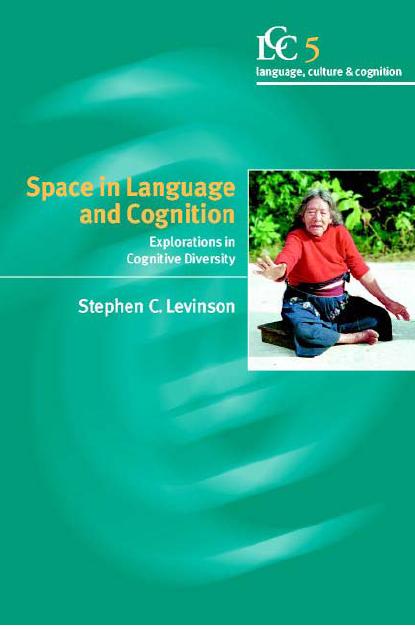There have been some very interesting discussions of the relationship between language and thought recently, including for example, Sean’s absolutely fascinating series of posts about the evolution of colour terms, a great post on descriptions of motion in different languages over at the lousy linguist (here), Guy Deutscher’s article “Does Your Language Shape How You Think?” (for discussions, see e.h. here and here), a slightly less recent piece by Lera Boroditsky in the Wall Street Journal, and an excellent recent discussion of her article by Mark Liberman (here). (see also James’ post, including a great/terrible joke about Whorf).
One of the things that Deutscher wrote in his article was that:
“The area where the most striking evidence for the influence of language on thought has come to light is the language of space — how we describe the orientation of the world around us.”
As I’ve written a bit about this topic on my other blog, Shared Symbolic Storage, I’ll repost a short series of posts over the next couple of days.
As Deutscher said, this is a very fascinating avenue of linguistic research that gives much insight into the nature of language and cognition as well as their relationship. In addition, it also presents us with new facts and considerations we have to take into account when we think about how language and cognition evolved.

I will focus on the work of a research group the Max-Planck-Institute for Psycholinguistics in Nijmegen, Netherlands and especially on the introductory part of co-director Stephen Levinson‘s (2003) book “Space in Language and Cognition.”
Although I’ve written about the idea of frames of references and cognitive coordinate systems in linguistics and cognitive science before (see e.g. here, here, and here), I haven’t written much about linguistic data that bears on this question. And the research done by the people at the Max-Planck-Institute for Psycholinguistics in Nijmegen, Netherlands and others has shown that there is a surprising diversity in linguistic frame of references across cultures.
What exactly does this mean for any account of cognition? How does this affect our thinking of the relationship of language and thought?
Broadly speaking, we can divide positions on the relationship of language and thought in two camps: Firstly, there are people who tend to emphasize the importance of a ‘language of thought‘ over language itself (e.g. cognitivism). Secondly, there are others tending toward the view that language and culture shape your cognitive style to a significant amount (e.g. linguistic relativism, linguistic determinism). The latter theorists can be called “lumpers”, who do not see it necessary to distinguish between the semantic content of a language and underlying conceptual representations, and the former theorists can be called “splitters” who insist on this distinction. (Levinson 1997: 13f.). Of course the lumper-splitter distinction is more of a continuum than a clear-cut divide.
 However, the issue is often portrayed as a black and white matter, with Benjamin Lee Whorf being portrayed as the bad guy who had a way too extreme view. This, however, is misguided, as Whorf’s main interest was not to advocate any idea of linguistic determinism per se but instead to stress the importance of how perspectives embodied in a language influence what we pay attention to in a situation and also how we conceptualise it:
However, the issue is often portrayed as a black and white matter, with Benjamin Lee Whorf being portrayed as the bad guy who had a way too extreme view. This, however, is misguided, as Whorf’s main interest was not to advocate any idea of linguistic determinism per se but instead to stress the importance of how perspectives embodied in a language influence what we pay attention to in a situation and also how we conceptualise it:
“‘users of different grammars are pointed by their grammars toward different types of observations and different evaluations of externally similar acts of observation, and hence are not equivalent as observers but must arrive at somewhat different views of the world’” (Whorf 1956: 221).
This is not to say that language is a prison we can’t get out of. But, as language and social practices can be said to embody certain perspectives on the world, it is reasonable to argue that a child growing up in a certain community will also learn to adopt and construe these perspectives during her cognitive development. As language is a primary source that introduces children to new ways of organizing the world around them, it stands to reason that the concepts and viewpoints expressed in a language have a significant impact on cognitive representations.
Of course research on the non-linguistic cognition of infants and non-human primates has shown that their mental representations are already surprisingly sophisticated and complex. Some of these cognitive capacities are proabably specified innately or at least helped by innate biases. Others may emerge due to the nature and early imprint of cultural interaction. But some concepts, namely abstract, relational ones, seem to be absent from non-human cognition completely, and in humans seem to be provided and picked up primarily by and through language during cognitive development. In fact, research on infant and childhood cognition supports the fact that the acquisition of relational concepts with the help of language may be one of the key factors that made us “so smart” (Gentner 2003, Penn et al. 2008).
If we bear this in mind, the question then is not whether language influences or determines thought, but to clarify the interactions and relationship between innate biological propensities, the environment, language and other cultural practices and processes. If, for example, we allow for multiple modes of representation in cognitive processing we may get a much clearer view on the issue. If, as mentioned above, we see semantic representations and conceptual representations as different levels of representation we can accommodate the variety of semantic distinctions in different levels with maintaining some form of ‘psychic unity of mankind’ with shared atomic concepts across our species. (Levinson 1997)
In my next post I’ll write about how the research done by the Max-Planck-Institute for Psycholinguists on the relationship between cross-linguistic differences in descriptions of space sheds light on this topic.
References:
Gentner, D. (2003). Why we’re so smart. In D. Gentner and S. Goldin-Meadow (Eds.), Language in mind: Advances in the study of language and thought (pp.195-235). Cambridge, MA: MIT Press.
Levinson, Stephen C. (1997) From outer to inner space: Linguistic categories and non-linguistic thinking. In E. Pederson & J. Nuyts, eds., With Language in Mind: the Relationship Between Linguistic and Conceptual Representation, 13-45. Cambridge: Cambridge University Press.
Levinson, Stephen C. (2003) Space in Language and Cognition : Explorations in Cognitive Diversity. West Nyack, NY, USA: Cambridge University Press.
Penn, Derek C, Keith J. Holyoak. and Daniel J. Povinelli (2008): Darwin’s mistake: Explaining the discontinuity between human and nonhuman minds. In: Behavioral and Brain Sciences (31:2): 109-130.
Whorf, B.L. (1956,) Language, thought and reality, Cambridge, MA: MIT Press.
